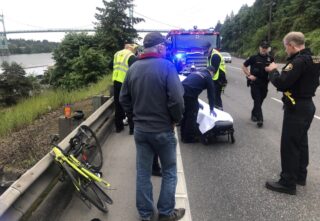
(UPDATE, 12:36 pm: We know now the victim is Merritt Raitt, a well-known local rider. Read more about him in a note at the end of this post.)
This morning a man riding a bicycle was hit by a car driver while trying to cross over lanes of Highway 30 just north of the St. Johns Bridge.
The collision hasn’t been reported by authorities or on other media outlets, but we received details about it from a reader who was driving nearby and pulled up a few minutes after it happened.
According to our source (who pulled over to help the rider) the bicycle rider was riding northbound on Highway 30 and had just gone under the St. Johns Bridge. He then tried to merge across two lanes in order to enter the left turn lane that would take up onto NW Bridge Avenue to access NW Germantown Road (or the bridge).
“He safely pulled in front of a truck to get to the left turn lane,” our source shared. “Rider then merged into the next lane to the left and the truck driver watched him get rear ended by the car. Car driver (who said she hit him at 55 mph*) said she saw him come into her lane and veered into the left turn lane to avoid him. Hit him and her windshield shattered.” (*Note: Speed limit at this location is 45 mph.)
Thankfully, the bicycle rider appeared to be OK although this person we heard from said he definitely hit his head and likely suffered a concussion.
Advertisement
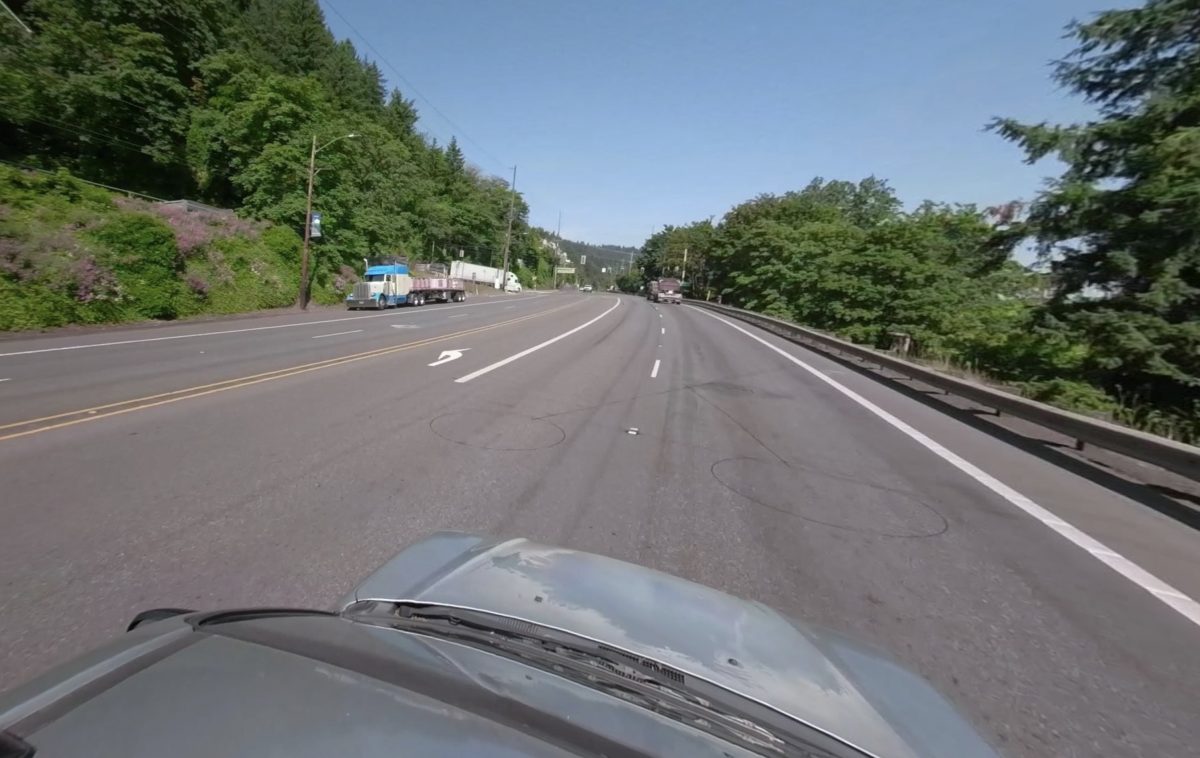
Highway 30 is a very important and well-used route for bicycle riders. It’s the only direct (and flat) way to access Sauvie Island and the West Hills/Forest Park from Portland. Despite this, the Oregon Department of Transportation has resisted changes that would increase cycling safety.
In 2016 we highlighted a major ODOT paving project that included this exact location. That project was a perfect opportunity to increase cycling space, lower speed limits, add more caution signage, and do more to make drivers aware that this is a popular cycling corridor. We made several reasonable suggestions to ODOT staff and they ignored them.
Last year advocates once again organized to encourage ODOT to make bike safety updates as part of a scheduled paving project.
This morning’s collision might have been difficult to prevent because merging across multiple lanes of a highway is almost always a risky proposition. But the lack of safety on Highway 30 — for all types of users — is unacceptable and something needs to change.
———
UPDATE, 12:38: The rider was 60-year-old Merritt Raitt. He just emailed us from Emanuel Hospital where he’s recovering. He has seven broken ribs, a mild concussion, some chipped teeth, lots of sore muscles and “very little road rash”. He’ll be there overnight but considers himself “extremely lucky”. He also shared his recollection about what happened:
“I don’t remember getting hit but I do remember merging to get to Germantown and my memory is I had plenty of room and made it to the turn lane where the light was red and that is the last thing I remember before waking up in the ambulance. I know that is a tricky crossing and I have done it many times. I’m not saying the witnesses have it wrong. .. I really feel like the made it to the turn lane and was hit there. I don’t want to make a big deal out of this.”
Raitt is a well-known local rider. Not only is he one of the strongest climbers in Portland (especially for his age) he’s also the guy behind that amazing “Commuter Dreams” video that earned him international acclaim back in 2010. He also made a film about his “Circle Century” around Ladd Circle in 2011.
———
UPDATE, 1:28: Here’s what the Portland Police Bureau says about the collision:
Preliminary information suggests the bicyclist and the vehicle were both traveling northbound on Hwy 30. The vehicle was traveling in its lane of traffic and the bicyclist was in the bike lane. As the two approached the intersection of Northwest Bridge Avenue, the bicyclist crossed Hwy 30 against the crossing signal and collided with the front passenger side of the vehicle, which had the right of way.
The bicyclist was transported by ambulance to a nearby hospital with trauma injuries.
Both the driver of the vehicle and the bicyclist were given the investigating officers’ business card and the PPB case number. Witness were interviewed and police reports have been written. No citations were issues in regards to this crash.
“Against the crossing signal” is a strange thing to say because Raitt wouldn’t have been using one. He’s an experience rider who was merging across lanes. He wasn’t using the crosswalk. It’s still unclear how the PPB determines the driver had the right-of-way.
— Jonathan Maus: (503) 706-8804, @jonathan_maus on Twitter and jonathan@bikeportland.org
— Get our headlines delivered to your inbox.
— Support this independent community media outlet with a one-time contribution or monthly subscription.




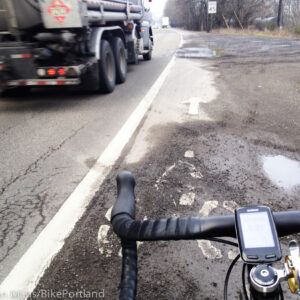
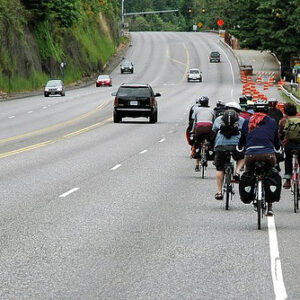
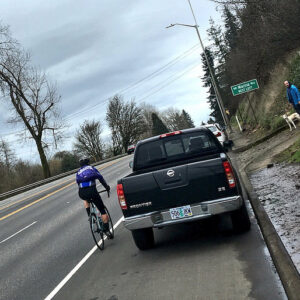
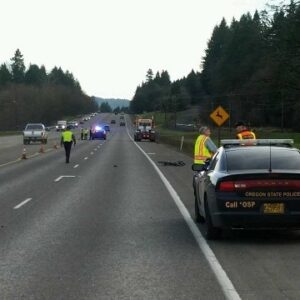
Thanks for reading.
BikePortland has served this community with independent community journalism since 2005. We rely on subscriptions from readers like you to survive. Your financial support is vital in keeping this valuable resource alive and well.
Please subscribe today to strengthen and expand our work.
#odotknows
the same ODOT that told us that they didn’t care for Vision Zero, preferred instead to tally ‘Fatality-Free-Days’
I hate riding HWY 30. It needs to be fixed.
Has there been any support in extending the westside/eastside waterfront path to St. Johns bridge/Sauvie bridge?
There is the North Willamette river path or greenway, can’t remember what they actually call it. It would connect Cathedral park to the eastbank path.
It has as much substance to it as the 2030 bike plan though
npGreenway has been advocating for the completion of extension of the Eastbank Esplanade north to the confluence of the Willamette and Columbia Rivers. Join us. npgreenway.org
Hwy 30 is a menace. It really sucks that you have to ride on it to get to Sauvie. It would be so easy for them to make it better too. It really wouldn’t take all that much. ODOT just has no problem with people getting killed so they don’t. It’s disgusting.
If PDX can’t get control of its streets from Oregon then maybe it needs to become its own state. I am not sure if the goals of Oregon are reconcilable with the goals of Portland
Excellent reason to make a protected path along Hwy 30 and the St. John’s. Correcting inherently dangerous designs by separating modes should be ODOT’s priority.
This would be expensive and could make things worse by limiting options for cyclists trying to cross the road while making them less visible to vehicles pulling off.
The problem is not getting hit while riding straight — it is crossing a busy fast road.
Separation is a weird goal out here anyway. I can’t think of any roads in the hills people would be riding to that even have shoulders.
Remember when one makes an argument against protected paths, one is limiting WHO can ride. Some people might be willing to ride next to large, heavy, fast moving objects, but road cyclists are a very small percentage of people on bikes and people who are walking. Dirty 30 is a barrier to all the people who want to walk, all the families who want to bike, and all the people who don’t want to die by car. Forest park and Sauvie Island could be safely accessible to a lot of people given a change in road design.
30 is not appropriate for those riders — removing barriers in places where they might actually go is far more important.
They have to get to and from 30, the distances are too long, and the environment is noisy and visually uninteresting. In addition hook risk will be worse and crossings more problematic.
Wasting resources that could provide significant benefit to these groups where they might actually go on aspirational infrastructure designed to instill a false sense of security is a disservice at best and dangerous at worst.
I remember hearing the exact same reason for not putting in a path along 17th and McLoughlin in Milwaukee. People said the distances are too long, 17th and McLoughlin are too noisy, crossings are problematic. The exact same thing is happening on Greeley. I just rode 17th and saw dozens of people on it last weekend. People want to travel by bike and walk. People want access to a lot of places where roads are barriers.
I’m guessing you think families don’t ride to the Banks Veronia trail because there’s no separated path along 26.
Four critical differences between those places you mention and 30 is that there are places to go, people live nearby, the distances are shorter, and speeds are much lower.
There are Forest Park entrances which wouldn’t involve as much distance, but those roads are way too steep for beginners who have enough trouble with the short and much gentler pitches on bridges and small hills in town.
Imagine spending an hour alongside large, heavy, fast moving objects, then thinking “a barrier would make this nice for everyone!”
I ride 3000 miles a year, I don’t think about getting hit while riding straight in the “bike “lane on Hwy 30, but “normal” people do. It is the epitome of where “normal ” people would not ride a bicycle.
Separation for 6 miles or so is a dream but that is the only way hwy 30 becomes anything other than an experienced Road bike person bike route and even then accidents like this will happen.
dwk. Not sure why you are calling this an “Accident”. It sounds like if the driver were not speeding, and perhaps was paying attention to the fact that a person on a bicycle could potentially merge in front, the driver could have had better reaction time. I think of accidents as events that are not predictable or preventable (swallowing a fly while talking, etc.)
Accidents can be both predictable and preventable. It is predictable that if I take enough risks while working on my roof, sooner or later I will fall. I could prevent that outcome by wearing protection or being more careful. Yet if I do fall, it would be an “accident” because the outcome was unintentional.
“Accident” speaks to intentionality, not preventability.
Speeding is an intentional act. If you drive with an intention of being as safe as possible, you will not exceed the speed limit. If every road user moved with safety as their primary intention, the vast majority of traffic collisions would evaporate.
So is trying to see how far I can kick a soccer ball from my roof. It doesn’t make the subsequent fall any less accidental.
You absolutely can make accidents less likely; this is the whole raison d’être for agencies like OSHA.
(I think speeding is better described as a careless act,
but let’s not pick nits.)
Exactly–“mormal” people are people who don’t ride bikes anywhere but think they might…..someday….with enough insulation and no need to develop any skill.
I’m sure the motorist was given a PAINFUL slap on the wrist for recklessly and negligently speeding!
JK, did PPB make the cyclist apologize for attacking her car with his body?
Yep. Sad that this facility will now score better for safety “enhancements” now. ;-(
This is one of several reasons that I dream of a “foot ferry” (bicycles too) from Frenchmans Bar Park to Sauvie Island…traffic safety and [natural disaster] security. Perhaps a Frog Ferry 2…someday…
UPDATE, 12:38: The rider was 60-year-old Merritt Raitt. He just emailed us from Emanuel Hospital where he’s recovering. He has seven broken ribs, a mild concussion, some chipped teeth, lots of sore muscles and “very little road rash”. He’ll be there overnight but considers himself “extremely lucky”. He also shared his recollection about what happened:
Raitt is a well-known local rider. Not only is he one of the strongest climbers in Portland (especially for his age) he’s also the guy behind that amazing “Commuter Dreams” video that earned him international acclaim back in 2010. He also made a film about his “Circle Century” around Ladd Circle in 2011.
There was another collision in that area in the news recently: https://www.koin.com/news/crashes/bicyclist-hurt-in-crash-on-hwy-30-in-nw-portland/
Yikes, glad to hear the rider is recovering.
I haven’t ridden on Hwy 30, but looking at online maps I was hoping maybe you could make a two-point left turn at the light. But then I looked at street view photos, and there’s almost no space at all to wait. Seems like it’d be about as dangerous waiting in the shoulder next to speeding traffic as to try and move with it. No idea how TriMet thinks people are supposed to cross this highway to catch the bus there, either.
UPDATE, 1:28: Here’s what the Portland Police Bureau says about the collision:
“Against the crossing signal” is a strange thing to say because Raitt wouldn’t have been using one. He’s an experience rider who was merging across lanes. He wasn’t using the crosswalk. It’s still unclear how the PPB determines the driver had the right-of-way.
I love the amount of contradictory information in that statement.
Obviously PPB is doing a solid for the motorist but I’m wondering if they determined that the cyclist didn’t have right of way if he crossed a solid white line into the turn lane. Who knows. Just more broken infrastructure from ODOT.
Is there any official statement? I’d like to email ‘ol Ted about it and see if he bothers to reply.
No citations were issues in regards to this crash.
The motorist admitted to driving 10mph over the speed limit and hitting a human being with her car and received no citations…
Lets all ask ourselves why ZeroVision is failing
No. PPB didn’t issue a news statement about this crash. I asked them about it directly.
From my experience, the police take a strong bias toward the driver because 1) they themselves see the world from a driver’s perspective and 2) the bicycle rider is usually either dead or in the hospital or unable to clearly recall what happened.
Unfortunately, the onus of guilt in our system is always on the bicycle rider in these type of crashes… especially when the driver isn’t being reckless or insane or drunk or full of road rage.
It would be up to the bike rider to disagree with the police and take the issue into his/her own hands. But often they are just tired and hurt and want to move on and insurance will cover everything so the cycle just continues.
Also keep in mind that we sometimes just will never know what truly happened. These are very stressful situations and no one has a clear memory of what happened. The police have a very difficult job (biases aside) in trying to figure out what happened. The driver and the biker can 100% believe they did something different. Humans are tricky that way.
I mean, if we had a functioning police force, they would investigate the crash and determine how fast she was going.
I guess the weird part of this is that motorist who hit him admitted to breaking the law and it seems like there are multiple witnesses who were not involved in the crash.
I mean, if he was crossing against the crosswalk, how could he get rear-ended? I know PPB is lazy, but this just seems next level lazy.
I wonder if I can request a copy of the police report.
Its impossible to determine how fast a car is going tho, since cars can’t tell you how fast they were going… its not like every person has a small GPS unit in their pocket and the government and google continuously log where you are and how fast you are going, second by second.
Agreed that the language is weird. I can only imagine the cop thinks someone on the shoulder is not on the road and must cross at the signal. Even if that’s the logic, I don’t think it will fly. Bicycles are allowed on the road and there’s no minimum speed, so this should be judged the same way as if a car came off the shoulder to make the same maneuver.
Do we know where Merritt was when he was hit? I’d assumed he was waiting in the left turn lane — i.e. clearly rear ended. However, if he made an error and pulled in front of a passing vehicle in a regular travel lane, that vehicle would have had right of way (and possibly no chance to react). This would be an unusual mistake for an experienced cyclist, but it does sometimes happen.
It can easily happen if the motorist is speeding, giving the cyclist less time to get across than they expect.
Wasn’t ODOT supposed to build a multi-use path parallel to this highway years ago? I kept hearing from people in planning circles it was some stipulation they were supposed to honor as part of a funding package they received or something, but never did.
Anyone else add details to this?
No, unfortunately there has never been a requirement to build a separated facility.
There have been a number of articles here promoting the idea, but I don’t think there have ever been official plans.
The rider’s account makes sense. The driver’s account also makes sense, and is close to his account. The problem could have been that she was going too fast, so he thought he had time to get across her lane, but didn’t. And she wasn’t paying attention enough, and was going too fast to slow down, so tried to veer left as she said, and hit him.
The police report doesn’t make sense unless both the other accounts are way off. Both rider and driver said he was merging across lanes, not crossing at a signal. And why would her windshield be broken if he hit the side of her car? I guess it’s possible.
The original source of information seems to also be a witness, and their account matches both vehicle operators. There is also a good chance the truck in the right hand lane behind the cyclist obstructed the view of both operators, particularly the cyclist since he never mentioned seeing the car. While the statement about the signal makes no sense, no charges does since there seems to be contributing negligence, speeding on the part of the car, and unsafe lane change on part of the cyclist. Perhaps the cyclist made it to the left turn lane, but that is where the car went to try to avoid him. Thankfully he hit the fender first and not the front end of the car. Suspect it would have been a much more tragic event. Fortunately the cyclist will recover.
This is similar to a pedestrian “double threat” scenario…one road user merging across lanes with the lead driver yielding to the “traffic” ahead while the POV of the approaching driver is screened by the yielding driver. This is one of the safety flaws to higher speed multilane urban highways without enhanced crossings and formal facilities for vulnerable roadways users.
I think you nailed it, Todd. Four-lane highways are so dangerous to VRUs for exactly that reason: the VRU has to account for multiple possibilities, and Hwy 30 has such high speeds that cars will be on top of you before you know it. The VRU has a split-second to make the right decision (even more so for motorists, but they are protected by their steel cages and air bags).
Good point about the truck driver’s account also matching rider’s and driver’s.
In regard to any “unsafe lane change”, it may have been, but it doesn’t seem certain. If he was in the turning lane and he got hit from behind, that means he wouldn’t have been hit if the driver had just kept in her lane. It seems you could argue that if he was already in that lane, then the driver was the one who made a dangerous lane change into him. If he hit the side of her car, then it seems she would have hit him in her lane, making it more likely he made an unsafe lane change.
The big question to me is, if the only reason your lane change was dangerous was because the person who hit you was speeding, is it still an unsafe lane change? It seems that logically, it is if the person whose lane you enter is going the speed limit or slightly faster. What if they’re going way faster?
This question came up when I was reading comments about a street race here about a year ago. A driver was killed when he made a right turn from a stop sign into the path of someone driving maybe 80 or 90 in a 30 or 35 zone. The racer was arrested as I recall. Someone commented that the victim was the guilty one because he came out from a stop sign into the path of someone using the lane who had the right of way. That sounded crazy because of the speed involved. But what if the driver was going 10 mph over (as she claimed)? What if she was really going 20 over?
Glad to hear that Merritt is recovering, he sounds like one lucky dude. Thanks for reporting Jonathan.
I am thankful the cyclist (and the driver*) are still alive. There must have been at least 30+ mph speed differential between these vehicles.
*the driver’s high-speed evasive maneuver could have caused them to roll or hit oncoming [truck] traffic head-on.
Would someone follow up on the status of the other injured cyclist reported (7 May 2020) near this same location?
I’ve often ridden this route but merge with the turn lane on the south side of Highway 30, before it goes under the bridge. Highway 30 is a dangerous road, full of rural commuters, work trucks, who, by-and-large have little respect for bicyclists. The highway should be called ‘interstate 30’ as that would more accurately reflect the speeds of motor vehicles that one sees.
For a bicyclist it presents the same problem as another dangerous intersection across the river: the onramp to 1-5 as one pedals south along N. Greeley Ave. The cyclist, moving along a long straight bike lane has to move left into traffic at the entrance to a freeway in order to continue along that street.
What is the solution? Stop your bike! Turn your head and look back. Do not trust your mirrors.
I hope he has a speedy recovery.
The “driverless vehicle” statement betrays their allegiance to the all mighty car.
This is why speeding kills vulnerable road users. You look down the street, know you have enough time to cross if the vehicle is going the speed limit, but they’re not and they get to you too soon and you’re dead.
Seems to me that if the car driver had no been speeding there would have been plenty of time to make it across the lane. It sounds like they DID make it across the lane but the driver thought they were going to hit the cyclist and veered into the cyclists path in the turn lane.
Exactly! In talking about reducing speeds of urban drivers, we always talk about the speed of impact, and the fact that the risk of dying goes up disproportionately with speed.
The other factor that we less often talk about is that higher speeds cause crashes that wouldn’t even occur at higher speeds. Partly because of driver reaction distance and stopping distance, but also because higher vehicle speeds make it harder for others to properly look out far enough to detect approaching hazards, and gives them less time to cross.
I’ve been in a similar situation where I was riding in the shoulder and then merged into the traffic lane with the intent to continue into the left turn lane. There was a car some distance behind me, but everything would have been fine if they kept on their path. However, they saw me coming, freaked out, and accelerated into the left turn lane to get around me right as I was about to enter the left turn lane. Fortunately, I somehow saw them out of the corner of my eye and veered back into the travel lane as they sped around me. (I think that’s what happened – it went so fast that I can’t be sure.) That was the day I decided to start riding with a mirror!
I’m sorry Mr. Raitt was not so lucky – I’m sorry about the pain he must be in (both physical and psychological) and wish him a full and swift recovery.
I am interested to know the type of vehicle. A lower hood height may be one of the reasons that Merritt came away from this without much more serious injuries.
More importantly, I am extremely glad he is relatively ok. Hopefully, he’ll have a speedy recovery.
Working in NW industrial area and living in St Johns, it took me a long time to figure how to (more or less) safely transit onto the bridge from NB US30. There is a crosswalk at NW Front Ave about 1/8 mile prior to the turn lane onto the bridge. I learned to hit the crosswalk button and keep pedaling, listing for traffic to stop. By that point i was usually able to cross two travel lanes to the the center turn lane leading to the bridge.
This is not ideal, but the safest way I know. And were i wanting to continue to Germantown, this would require crossing the bridge lanes at the west end and then continue to Bridge Ave to Germantown.
Sad to hear about this and every collision. And looking forward to real facilities being designed that prioritize all road users as opposed to motor traffic.
Haha. Thanks for this. I love the idea of triggering a stoplight in advance of a turn to stop traffic.
Thanks for the pro tip. I live in St Johns and work downtown. I usually avoid biking in the bridge or hwy 30, but have to use it sometimes. I never thought about using the pedestrian beg button to buy time to merge into the turn lane south of the bridge ramp. That’s genius!
Brilliant! Never thought about that, and I worked on Front Avenue for years. I have, however, made the exact maneuver made by Mr. Raitt many times, both to get onto the ramp on the south side of the SJB, as well as the north-side ramp where he got it.
The West Hills/Forest Park are accessible from a wide variety of roads, not just Hwy 30. Am I mis-reading this sentence?
The other routes (e.g. Skyline) involve significant climbing and undulation, with a large number of curves, making 30 easily the most direct option.
This is why I hope we have a multi-use path built on the southwest side of the road. Building one on the northeast side would do nothing to eliminate these conflicts when accessing the bridge.
with a 35+mph speed differential, it seems this guy is pretty lucky to be alive. Report is that he was hit by a car, and from the bike frame damage, it looks like the frame absorbed a lot of that initial energy. I don’t think this would have gone as well for him if he had been hit by one of the Bro-dozers that so frequently ply HWY 30 at speeds well over the posted limit.
The police report sounds like an out and out lie. The officer’s description is shameful and it should be criminal. People on bikes have a right to merge into traffic to change lanes. To use the terminology that is generally applied to pedestrian crossing when referring to what is obviously a vehicular movement, frames the incident in a way that implies that the bicyclist committed a traffic infraction, despite the fact that all eyewitness accounts suggest that the cyclist was not at fault, or at least was behaving in a way that is legally permissible. If the officer really believes their own account, they should have cited the cyclist for jaywalking.
I mean, how can the officer write in one sentence that the cyclist was ‘traveling northbound’ on St Helens and in a later sentence say that he ‘crossed against the signal?’ If he was traveling northbound then his movement was a merge or a lane change. If he had been traveling westbound, then the crossing with or without a signal would have been the appropriate determination.
In a sane world, people who are paid to enforce the law should be reprimanded for making statements that show they clearly don’t understand the law. This isn’t even a difficult one. How dumb and/or biased are these officers?
Has PPB still not issued a clarifying statement? How on earth could they say he was crossing against the signal? He wasn’t at the signal, he wasn’t crossing, he was changing lanes!
Apparently anyone not in an automobile is a pedestrian to the officer who made this statement? Talk about cyclist nullification.
Yes. They just got back to me and acknowledged that they got it wrong:
Wait, the ppb is claiming that the bicyclist hit the vehicle???? He must have been moving fast to catch up with and hit a car doing 55mph.
Two years ago, I hit a car. I was going about 30 mph downhill in heavy traffic, and just as I passed a pickup truck, he turned right in front of me (no signal or anything), going about 15 mph. I hit his right front passenger door with my left hip and handlebar. I bounced off and hit the deck. Suprisingly, only my right hip was dinged up a a bit, and my bike was mostly OK. I put a major dent into his door. He was cited, and I claimed lots of pain and suffering and got a nice settlement and a new bike I had to fight his insurance company, but once I showed them the police report and several eye-witness accounts, they settled. btw, if he had hit me, say broadside, I would have been seriously injured. I was lucky.
That corrected statement is sloppy. There are two vehicle lanes plus a turn lane. The correct statement (without even arguing about who hit who) would be, “The rider crossed out of the bike lane, and across the two vehicle lanes, hitting the vehicle in the turn lane”.
The statement they gave would only make sense if it were a single-lane road, and the collision happened in that lane, not the turn lane. The sloppiness gives me the impression the police are thinking, “Well, the bike was in the vehicle lane, not the bike lane, so it had to have been the biker’s fault. Anything beyond that is just a technicality, so no point wasting time on accuracy of irrelevant details”.
Maybe you should ask them for a third try.
JM will you PM me which PPB officer told you that? Thanks.
MG
Yes. Sure. I’ll be in touch.
This is why we have speed limits. It isn’t just about the unfriendly physics of impact speeds. At higher speeds, things happen faster, and incidents occur that wouldn’t happen at lower speeds. If the driver had actually been going the speed limit, Mr. Raitt would have had a higher probability of getting across without getting hit – and would have had an easier time finding a gap to get across in the first place.
I’ve made this left turn a number of times, and sometimes had to stop and wait on the shoulder for a safe gap (itself not a very safe thing). There have been also been at least a couple times it ended up being dicier than expected because oncoming traffic was quite a bit over the speed limit. Lower speeds would make the whole thing geometrically less dangerous.
Let’s do a little math here: if the driver was actually going 55 mph as claimed, in the traffic lane, that’s covering 90 feet of pavement per second. How long does it take to ride a bike from the shoulder, across two lanes of traffic, and to the left-turn lane? Even a strong rider is going to take a few seconds. Also, there’s very good reason to do it on the move, it will take at least twice as long to do it from a dead stop. If it takes 5 seconds to get across while moving, for example, that means a cyclist has to not only look for gaps in traffic at least 450 feet back, assuming they want to detect vehicles going 55 mph or less, but accurately judge the approach speed – all while looking over their shoulder. If traffic is heavy enough to force a stop, at least you can see traffic more clearly … but now you’re looking at a 10-second crossing, so then you have to look back at least 900 feet for this particular motorist, or about four Portland city blocks. Even 900 feet may not be enough if the vehicle is going 70, which is not uncommon on Dirty Thirty. I can fairly well judge the speed of approaching vehicles maybe 100-200 feet back, but three football fields? Pretty tricky.
This is why we need to get serious about speeding again.
HWY 30 has enough high-speed crossover and T-bone type crashes resulting in injury and death, that it should have speed cameras every mile or so. The driver behavior on this road is outrageous.